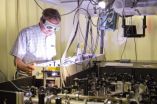(Press-News.org) In a critical step that may lead to more effective HIV treatments, Harvard scientists have found pre-existing mutations in a small number of HIV patients. These mutations can cause the virus to develop resistance to the drugs used to slow its progression.
The finding is particularly important because, while researchers have long known HIV can develop resistance to some drugs, it was not understood whether the virus relied on pre-existing mutations to develop resistance, or if it waits for those mutations to occur. By shedding new light on how resistance evolves, the study, reported in online journal PLoS Computational Biology opens the door to the development of new, more effective treatments.
Pennings collected her data from 26 clinical trials. Patients were treated with a typical combination of NNRTI drugs, which helps block the virus from multiplying. She found that the virus is more likely to develop resistance shortly after the start of treatment or when treatment is restarted following an interruption of a week or more. However, it is less likely to develop resistance later on and when patients do not interrupt treatment.
"In order to prevent the evolution of resistance, we need to know where the resistance mutations are coming from, it was exciting to realize data from clinical trials could help us solve this puzzle," Pennings said. "If we understand how the virus develops resistance, we can think of new ways to prevent it."
This finding suggests that pre-existing mutations are behind the virus' drug resistance, and that resistance which develops early in treatment is likely the result of pre-existing mutations. Resistance that develops later is tied to mutations in the virus that occur after treatment began.
While the study holds out hope for the future development of more effective HIV treatments, Pennings emphasized that data used in the study came from trials, which exclusively included patients receiving NNRTI or unboosted protease inhibitor treatments. It is unclear whether the results can be generalized to other treatments and to patients who are not enrolled in clinical trials.
INFORMATION:
FINANCIAL DISCLOSURE: This work was supported by a long-term fellowship of the Human Frontier Science Program. The funders had no role in study design, data collection and analysis, decision to publish, or preparation of the manuscript.
COMPETING INTERESTS: The authors have declared that no competing interests exist.
CITATION: Pennings PS (2012) Standing Genetic Variation and the Evolution of Drug Resistance in HIV. PLoS Comput Biol 8(6): e1002527. doi:10.1371/journal.pcbi.1002527
PLEASE ADD THIS LINK TO THE FREELY AVAILABLE ARTICLE IN ONLINE VERSIONS OF YOUR REPORT (the link will go live when the embargo ends): http://www.ploscompbiol.org/article/info:doi/10.1371/journal.pcbi.1002527
CONTACT:
Dr. Pleuni Pennings
Harvard University
Organismic and Evolutionary Biology
16 Divinity Avenue
Cambridge, Massachussets 02138
UNITED STATES
617 417 7311
http://scholar.harvard.edu/pennings/home
Disclaimer
This press release refers to an upcoming article in PLoS Computational Biology. The release is provided by journal staff, or by the article authors and/or their institutions. Any opinions expressed in this release or article are the personal views of the journal staff and/or article contributors, and do not necessarily represent the views or policies of PLoS. PLoS expressly disclaims any and all warranties and liability in connection with the information found in the releases and articles and your use of such information.
Media Permissions
PLoS Journals publish under a Creative Commons Attribution License, which permits free reuse of all materials published with the article, so long as the work is cited (e.g., Brinkworth RSA, O'Carroll DC (2009) Robust Models for Optic Flow Coding in Natural Scenes Inspired by Insect Biology. PLoS Comput Biol 5(11): e1000555. doi:10.1371/journal.pcbi.1000555). No prior permission is required from the authors or publisher. For queries about the license, please contact the relative journal contact indicated here: http://www.plos.org/about/media-inquiries/embargo-policy/
About PLoS Computational Biology
PLoS Computational Biology features works of exceptional significance that further our understanding of living systems at all scales through the application of computational methods. All works published in PLoS Computational Biology are open access. Everything is immediately available subject only to the condition that the original authorship and source are properly attributed. Copyright is retained.
About the Public Library of Science
The Public Library of Science (PLoS) is a non-profit organization of scientists and physicians committed to making the world's scientific and medical literature a freely available public resource. For more information, visit http://www.plos.org.
END
SEATTLE – In exploring the genetics of mitochondria – the powerhouse of the cell – researchers at Fred Hutchinson Cancer Research Center have stumbled upon a finding that challenges previously held beliefs about the role of mutations in cancer development.
For the first time, researchers have found that the number of new mutations are significantly lower in cancers than in normal cells.
"This is completely opposite of what we see in nuclear DNA, which has an increased overall mutation burden in cancer," said cancer geneticist Jason Bielas, Ph.D., whose findings are published ...
SAN FRANCISCO, CA—June 7, 2012—Scientists at the Gladstone Institutes have for the first time transformed skin cells—with a single genetic factor—into cells that develop on their own into an interconnected, functional network of brain cells. The research offers new hope in the fight against many neurological conditions because scientists expect that such a transformation—or reprogramming—of cells may lead to better models for testing drugs for devastating neurodegenerative conditions such as Alzheimer's disease.
This research comes at a time of renewed focus on Alzheimer's ...
For the first time, researchers have produced a coherent, laser-like, directed beam of light that simultaneously streams ultraviolet light, X-rays, and all wavelengths in between.
One of the few light sources to successfully produce a coherent beam that includes X-rays, this new technology is the first to do so using a setup that fits on a laboratory table.
An international team of researchers, led by engineers from the NSF Engineering Research Center (ERC) for EUV Science and Technology, reports their findings in the June 8, 2012, issue of Science.
By focusing intense ...
A breakthrough in laser science was achieved in Vienna: In the labs of the Photonics Institute at the Vienna University of Technology, a new method of producing bright laser pulses at x-ray energies was developed. The radiation covers a broad energy spectrum and can therefore be used for a wide range of applications, from materials science to medicine. Up until now, similar kinds of radiation could only be produced in particle accelerators (synchrotrons), but now a laser laboratory can also achieve this. The new laser technology was presented in the current issue of the ...
CINCINNATI – Scientists have discovered a new function for a protein that protects cells during injury and could eventually translate into treatment for conditions ranging from cardiovascular disease to Alzheimer's.
Researchers report online June 7 in the journal Cell that a type of protein called thrombospondin activates a protective pathway that prevents heart cell damage in mice undergoing simulated extreme hypertension, cardiac pressure overload and heart attack.
"Our results suggest that medically this protein could be targeted as a way to help people with many ...
Easy-to-use, inexpensive tests to diagnose infectious diseases are urgently needed in resource-limited countries. A new report based on an American Academy of Microbiology colloquium, "Bringing the Lab to the Patient: Developing Point-of-Care Diagnostics for Resource Limited Settings," describes the challenges inherent in bringing new medical devices and technologies to the areas of the world where they are needed most. Point-of-care diagnostics (POCTs) bypass the need for sophisticated laboratory systems by leveraging new technologies to diagnose infectious diseases and ...
(PORTLAND, Ore.) —June 07, 2012—Eleven integrated health systems, with more than 16 million members, have combined de-identified data from their electronic health records to form the largest, most comprehensive private-sector diabetes registry in the nation.
According to a new study published today in the Centers for Disease Control and Prevention's Preventing Chronic Disease, the SUPREME-DM DataLink provides a unique and powerful resource to conduct population-based diabetes research and clinical trials.
"The DataLink will allow us to compare more prevention and ...
There's new hope for development of an antibiotic that can put down a lethal bacteria or superbug linked to the deaths of hundreds of hospital patients around the world.
Researchers from the University of Alberta-based Alberta Glycomics Centre found a chink in the molecular armour of the pathogen Acinetobacter baumannii. The bacteria first appeared in the 1970's and in the last decade it developed a resistance to most antibiotics.
U of A microbiologist Mario Feldman identified a mechanism that allows Acinetobacter baumannii to cover its surface with molecules knows ...
Berlin, Germany, June 7 2012: Data presented today at EULAR 2012, the Annual Congress of the European League Against Rheumatism, demonstrates that tailoring biologic treatment to individual patients with rheumatoid arthritis (RA) can reduce total costs by €2,595,557 per 272 patients over 3 years (95 percentile range -€2,983,760 to -€2,211,755), whilst increasing effectiveness by an average of 3.67 quality-adjusted life years (QALYs)*. Cost savings were mostly on drug costs.
The Dutch study, which investigated 272 patients with RA starting adalimumab treatment, measured ...
Berlin, Germany, June 7 2012: Results from a retrospective analysis of contemporary data presented today at EULAR 2012, the Annual Congress of the European League Against Rheumatism, predict, based on estimates from a multivariate regression model, that the cumulative use of anti-tumour necrosis factor drugs (anti-TNFs) for one, two, or three years is associated with reduced risk of cardiovascular events by 24%, 42% and 56% in patients with rheumatoid arthritis (RA) respectively, compared to not using anti-TNF therapies (adjusting for background use of methotrexate or other ...


